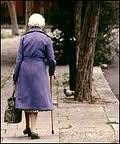
When a traffic light at a busy intersection flashes the WALK sign, people with knee osteoarthritis worry they can’t walk fast enough to make it across the street in time. New Northwestern Medicine research shows people with this common arthritis are more likely to walk fast enough if they lead physically active lives.“The more active people are, the faster they can walk,” said Dorothy Dunlop, associate professor of medicine at Northwestern University Feinberg School of Medicine and lead author of the study. “This is strong evidence that even a small increase in activity is related to better walking function. The bar for improvement isn’t that high. This should motivate people to get moving, even if they have pain or stiffness."The study is published in the January 2010 issue of Arthritis & Rheumatism.
Knee osteoarthritis is a leading cause of disability in adults. As it progresses, it can threaten an individual’s ability to live independently. Maintaining function and independent living is an important goal for the more than 27 million U.S. adults with osteoarthritis. Osteoarthritis may first appear between ages 30 and 40, and is present in almost everyone by age 70. Before age 55, it affects men and women equally, but after age 55 the incidence is higher in women.
“This study provides encouragement for people who are on the low end of the physical activity spectrum to increase their physical activity,” said Dunlop. “You don’t have to be in the top physical activity group before you start to see improvements in your walking speed.“
Physical activity produces big benefits for people with knee osteoarthritis. In addition to improving the ability to walk, physical activity also promotes healthy joint cartilage and reduces pain, depression and fatigue, Dunlop noted.
Federal guidelines recommend adults with arthritis should participate in at least 2.5 hours a week of moderate intensity, low-impact activity in sessions lasting 10 minutes or more. Even if people can’t meet these levels, Dunlop said they should be as physically active as possible.
Researchers divided participants into four physical activity groups, from lowest to highest, using a general activity score. In the lowest physical activity group, less than half, or 49 percent, walked fast enough to cross the street before the light changed. (Traffic lights generally allow a walking speed of four feet per second.) In the next three higher physical activity groups, 63 percent, 71 percent and 81 percent, respectively, walked fast enough to cross the street.
Author: Marla Paul is the health sciences editor at the Northwestern Feinberg School of Medicine.

Comments